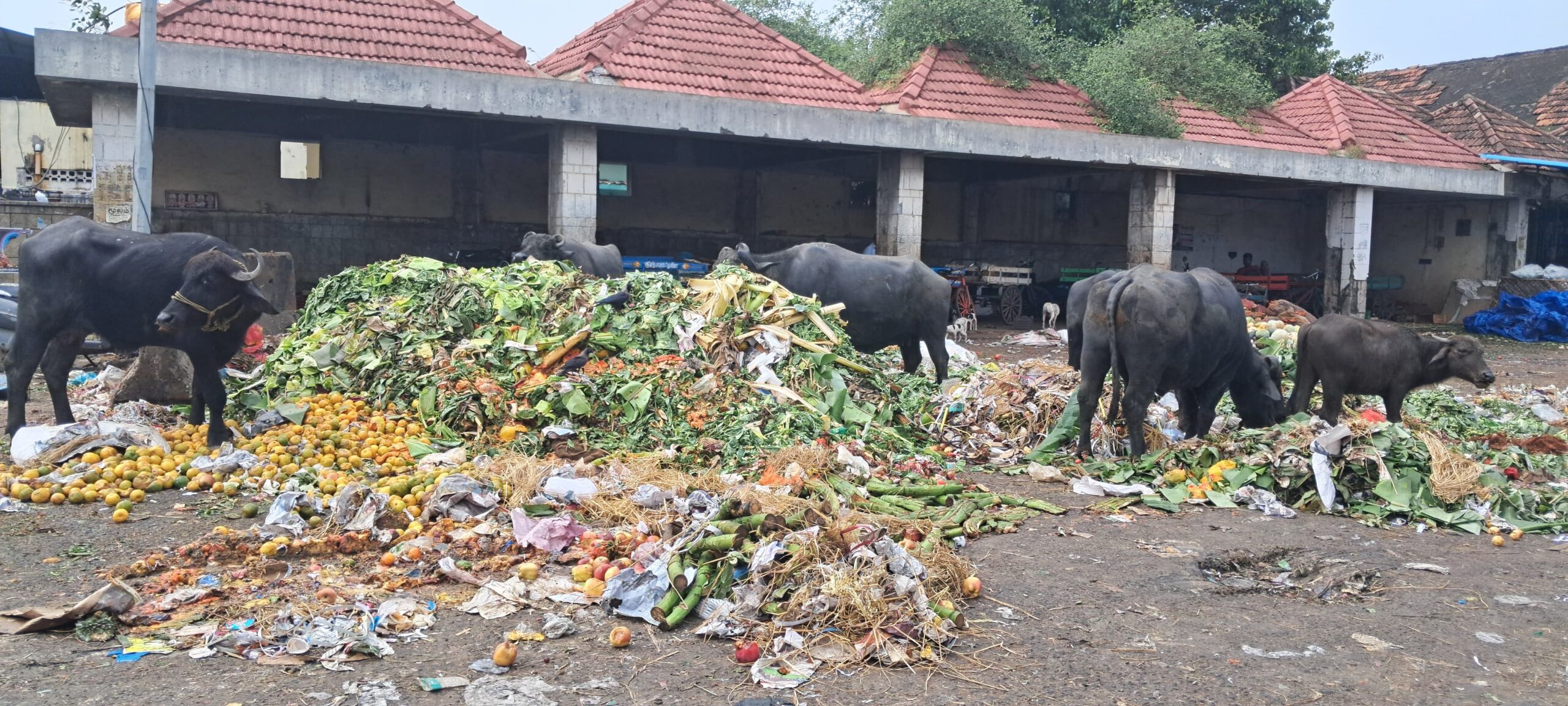As Koyambedu market continues to grapple with the looming waste management crisis, will authorities soon find a sustainable solution?
Published Nov 25, 2024 | 8:00 AM ⚊ Updated Nov 25, 2024 | 3:33 PM

Chennai’s Koyambedu Market is the largest market in Asia and has long been a hub for the city’s trade in fruits, vegetables, and other perishables.
Originally, the Kothawal Chavadi Market in Parry’s Corner was the city’s largest, supplying vegetables and fruits for both wholesale and retail trade.
However, due to traffic congestion, space constraints, and health concerns, in 1975, the Madras Metropolitan Development Authority (MMDA, now renamed CMDA) decided to relocate the market to Koyambedu.
Construction work on the Koyambedu Market started in 1988 on approximately 295 acres of land, with the market officially opening in 1996.
The first phase saw the establishment of 3,194 shops catering to perishable goods, 2,948 of which were allocated through tenders issued by the Koyambedu Wholesale Market authority under the Chennai Metropolitan Development Corporation.
In the first phase, 3194 shops were built for perishable goods, out of which 2948 were allotted through tenders floated by Chennai Metropolitan Development Corporation official in-charge of the market.
At present, Koyambedu Market is the largest commercial hub in Tamil Nadu, boasting 3,855 approved shops, including 1,951 vegetable shops, 941 fruit shops, 471 flower shops, and 492 miscellaneous shops.
Additionally, 500 grocery and food grain stores are located in a separate area including in platforms. Every day, approximately 15,000 lorries transport fruits and vegetables from various states and districts across India to the market.
In addition, retail traders also set up shops on the roadside or ‘platform’ encroaching on the roads in and near the market.
A quick visit to Koyambedu market makes one wonder whether the reasons for relocating the market from Parry’s corner has been even remotely achieved.
On a daily basis, 6,500 tonnes of fruits and vegetables are sold at the market. Of this, 72 tonnes are vegetable waste, 38 tonnes are fruit waste, 10 tonnes are flower waste, 73 tonnes are banana-related waste, and another seven tonnes are categorised as miscellaneous waste.
In total, approximately 200 tonnes of waste is generated daily, with the amount soaring to 300 tonnes during festive seasons.
No matter which part of Koyambedu market you lay your eyes on, you will see vegetable and fruit waste dumped.
Despite its vast size and importance, the sight of garbage scattered across the market has become an unfortunate reality, posing a huge health risk due to the presence of decaying produce.
Greater Chennai Corporation workers are tasked with cleaning the area daily, and contractors collect the waste, which is then transported to the Kodungaiyur landfill.
Local residents and workers continue to express frustration with the ongoing waste management issues, but are concerned officials lending an ear?
Speaking to South Fist, Parameswari Raja from Ambattur shared, “When you step into the Koyambedu market, you see the same garbage and waste wherever you turn. The stench makes people turn their faces when they cross some areas.”
Parameswari Raja from Ambattur said, “When you step into the Koyambedu market, you see the same garbage and waste wherever you turn. The stench makes people look the other way “.
Ramakrishnan, a daily wage labourer from Cuddalore district working at the Koyambedu market expressed similar frustrations.
“I have been working here for many years. Since trucks arrive at all hours, we sleep in any of the shops. But the mosquito infestation and the stench emanating from piled up garbage makes it impossible to get a good night’s sleep,” he told South First.
But as someone who hasn’t had an education, he continues to work at Koyambedu market despite all the risks it poses. “I continue to work here in hopes of supporting my family.”
Despite multiple promises from authorities, the issue mentioned above remain unresolved.
South First spoke to SS Muthukumar, President of the Small Wholesale Traders Association, about the waste management at the market.
“Koyambedu market administration does not have enough staff to manage waste that is generated. The garbage collection system is inadequate, which causes waste to pile up, especially in the vegetable market,” he said.
Elaborating on failure on the part of authorities to address the issue, he continued: “During rainy season, waste turns into a mushy swamp, with accumulated sewage adding to it. This causes foul smell, attracting flies and mosquitoes. We’ve been frequently appealing to authorities to address these issues and encroachment by shops.”
Despite multiple promises from officials, it appears that no action has been taken to address the issue at Koyambedu market.
Responding to the complaints from general public and others, Indumathi, Koyambedu Market Management Committee’s Chief Administrative Officer pointed out: “150 workers are deployed daily to remove waste on a daily basis, which is then transported to the Kodungaiyur landfill, 21 km away from the market.”
She acknowledged that the waste management system in Koyambedu market has its limitations “We are doing our best to manage the situation,” she said, but was unable to provide a clear solution to the ongoing crisis.
As the market’s waste crisis continues to worsen, both traders and workers face significant health risks. The accumulation of waste, especially in the vegetable market, not only affects the air quality but also contributes to the spread of pests and disease. Local traders are growing increasingly frustrated with the lack of effective solutions.
As the market continues to grapple with the crisis, one can’t help but wonder about the long-term sustainability of the current system.
Will the authorities take effective, timely action to address the growing waste problem and ensure a healthier environment for the traders, workers, and consumers who rely on the market?
(Edited by Neena)
